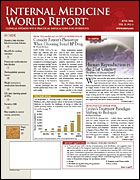New Test for Early Diabetes in High-risk Persons
New Test for Early Diabetes in High-risk Persons
SAN DIEGO—A standardized “fast food tolerance test” that uses a 2-hour capillary
postprandial glucose measurement may prove to be a practical early screening method for prediabetes and diabetes in high-risk individuals, investigators reported
at the 65th American Diabetes Association annual meeting. Peter Baginsky, MD, of Touro College, Vallejo, Calif, presented the results of a pilot trial in individuals drawn from underserved Latino communities in California, persons who are considered at high risk for diabetes. “There are >5 million Americans with undiagnosed diabetes and >41 million with prediabetes,” Dr Baginsky observed. “Since the risk of complications can be significantly
reduced through glycemic control and other measures, there is a need for
early and accurate diagnosis of diabetes. It is also important to diagnose prediabetes
since it carries an increased risk of cardiovascular disease and since interventions
such as diet, exercise, and medications can prevent or delay progression to diabetes.”
A barrier to the diagnosis of diabetes and prediabetes is the limited availability of
screening tools. While the oral glucose tolerance test (OGTT) is the standard method for detecting prediabetes and is the most sensitive screening tool for diabetes, it
is expensive, inconvenient, and unpalatable. In addition, the OGTT is unavailable
to many individuals who lack insurance, regular health care, and financial
resources—the very people who often have a particularly high risk of diabetes, Dr
Baginsky noted. Although other more convenient screening tools have been proposed,
including a logistic regression equation incorporating random glucose, age, gender,
and body mass index, and a test meal wafer composed of oat and soy, all such
methods have shortcomings. The study participants were evaluated after an overnight fast on 2 separate occasions, 1 week apart. On the initial visit, they were served a standard high-carbohydrate breakfast from a fast food restaurant, which had the following nutritional composition: 137 g carbohydrate, 21 g protein, 22 g fat, and 4 g dietary fiber. At 2 hours after the meal, a meter was used to measure capillary glucose level. On the second visit, a standard
75-g OGTT was performed. Of the 73 participants in whom complete
results were available, 12.3% had abnormal glucose on OGTT, 5.5% had
frank diabetes, and 6.8% had impaired fasting glucose and/or impaired glucose
tolerance. e fast food tolerance test had a sensitivity of 66.7% for predicting either prediabetes
or diabetes, a specificity of 98.4%, a positive predictive value of 85.7%, and a
negative predictive value of 95.5%. Dr Baginsky emphasized that one of the
objectives of the trial was to identify reasonable diabetes screening alternatives for
high-risk individuals with limited access to laboratory tests. Although this small pilot
study is not sufficient to determine whether this test is equivalent to the gold standard
of diagnosing diabetes, OGTT, “this convenient, easily replicable test is far more
accessible to individuals who, despite their increased risk, have limited access to medical
care,” he said. “Our results suggest that a fast food breakfast followed by a fingerstick capillary
glucose measurement offered to high-risk individuals may be a practical method of
initial screening, and its sensitivity in detecting diab screening for the metabolic syndrome,” he
predicted.—J.S.
